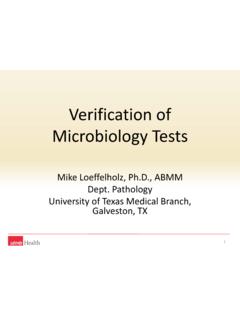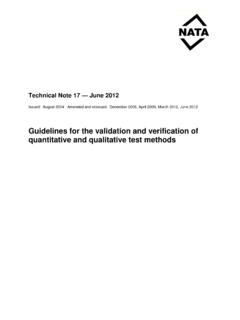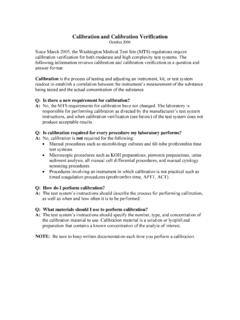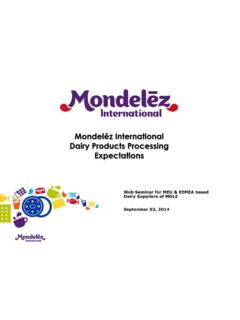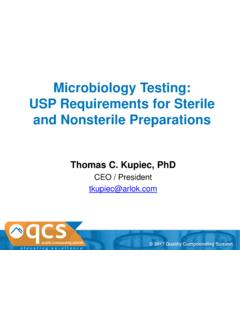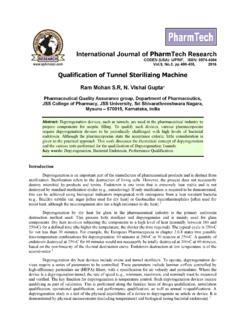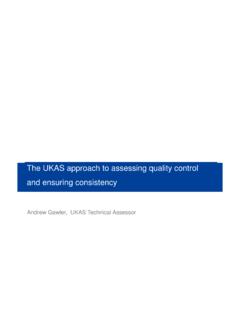Transcription of WHO GOOD PRACTICES FOR PHARMACEUTICAL …
1 Working document July 2010 RESTRICTED WHO good PRACTICES FOR PHARMACEUTICAL microbiology laboratories DRAFT FOR COMMENT World Health Organization 2010 All rights reserved. This draft is intended for a restricted audience only, the individuals and organizations having received this draft. The draft may not be reviewed, abstracted, quoted, reproduced, transmitted, distributed, translated or adapted, in part or in whole, in any form or by any means outside these individuals and organizations (including the organizations' concerned staff and member organizations) without the permission of the World Health Organization. The draft should not be displayed on any web site.
2 Please send any request for permission to: Dr van Zyl, Head of Inspections, Prequalification Programme, Quality Assurance and Safety: Medicines, Department of Essential Medicines and PHARMACEUTICAL Policies, World Health Organization, CH-1211 Geneva 27, Switzerland; e-mail: The designations employed and the presentation of the material in this draft do not imply the expression of any opinion whatsoever on the part of the World Health Organization concerning the legal status of any country, territory, city or area or of its authorities, or concerning the delimitation of its frontiers or boundaries. Dotted lines on maps represent approximate border lines for which there may not yet be full agreement. The mention of specific companies or of certain manufacturers products does not imply that they are endorsed or recommended by the World Health Organization in preference to others of a similar nature that are not mentioned.
3 Errors and omissions excepted, the names of proprietary products are distinguished by initial capital letters. All reasonable precautions have been taken by the World Health Organization to verify the information contained in this draft. However, the printed material is being distributed without warranty of any kind, either expressed or implied. The responsibility for the interpretation and use of the material lies with the reader. In no event shall the World Health Organization be liable for damages arising from its use. This draft does not necessarily represent the decisions or the stated policy of the World Health Organization. Please address comments on this proposal, by 1 October 2010, to Dr van Zyl, Head of Inspections, Prequalification Programme, Quality Assurance and Safety: Medicines, World Health Organization, 1211 Geneva 27, Switzerland, e-mail: with a copy to Mrs M. Gaspard During the past few years we have moved more towards an electronic system for sending out our working documents for comment, for convenience and in order to speed up the process.
4 If you do not already receive our documents electronically, please let us have your e-mail address (to and we will add it to our electronic mailing list. Working document page 2 SCHEDULE FOR THE PROPOSED ADOPTION PROCESS OF DOCUMENT : WHO good PRACTICES FOR PHARMACEUTICAL microbiology laboratories Topic identified by prequalification inspectors 4-5 April 2007 Proposal discussed in informal consultation on new approaches and risk evaluation for manufacture of medicines and subsequently recommended to next meeting of the WHO Expert Committee on Specifications for PHARMACEUTICAL Preparations 30 May-1 June 2007 42nd WHO Expert Committee on Specifications for PHARMACEUTICAL Preparations adopted a recommendation to prepare new guidance 15-19 October 2007 Identification of resource person and preparation of first draft text by Dr Deus Mubangizi (WHO Prequalification Inspection Programme) December 2007- March 2009 Presentation of first draft to inspectors assisting in the WHO Prequalification Programme at meeting on good manufacturing practice(GMP))
5 And inspections, Geneva, Switzerland 2-3 April 2009 Circulation for feedback among specialists April-June 2009 Discussion during informal consultation on WHO guidelines for medicines quality assurance, quality control laboratories and transfer of technology of feedback received 27-31 July 2009 Mailing (wide distribution) of document for comments August 2009 Review of comments received September-October 2009 Revision drafted by Mr Neil Raw, GMP Inspector, London, United Kingdom October 2009 Presentation as a draft document to 44th WHO Expert Committee on Specifications for PHARMACEUTICAL Preparations 12-16 October 2009 Circulation of revised draft for comments November 2009 Collation of comments received February-March 2010 Discussion during the information consultation on quality assurance systems.
6 Medicines and risk analysis 4-6 May 2010 Working document page 3 BACKGROUND The WHO Expert Committee on Specifications for PHARMACEUTICAL Preparations adopted in 2009 a revised version of the good PRACTICES for PHARMACEUTICAL quality control laboratories (1). During the inspections carried out when prequalifying laboratories , the inspectors had noticed that some of the texts of these guidelines might benefit from additional guidance, with a special focus on microbiology . In light of the above, the Expert Committee recommended that the WHO Secretariat initiate the process of developing a new text on good PRACTICES for PHARMACEUTICAL microbiology laboratories .
7 On the basis of the above, the following text is proposed to cover this specific type of laboratory. Revision 2 of document mailed out for comments August 2010 Presentation to WHO Expert Committee on Specifications for PHARMACEUTICAL Preparations 18-22 October 2010 Further follow-up as necessary Working document page 4 CONTENTS page Introduction and scope of 5 Glossary .. 6 1. 7 2. 8 Premises .. 9 Environmental monitoring in the 8 Cleaning, disinfection and 9 Sterility test ..10 3. Validation of test methods .. 11 4. Equipment .. 12 Maintenance of 12 Qualification .. 12 Calibration and monitoring .. 12 5. Reagents and culture media .. 15 Reagents .. 15 Media .. 15 Labelling .. 16 Media resuscitation .. 16 6. Reference materials and reference cultures.
8 17 International standards and pharmacopoeial reference 17 Reference 17 7. Sampling .. 17 8. Sample handling and identification .. 18 9. Disposal of contaminated 19 10. Quality assurance of results/quality control of .. 19 Internal quality 19 11. Testing procedures .. 19 Sterility testing .. 19 12. Test 19 20 Appendix A: General use of reference cultures .. 22 Appendix B: Examples of calibration and calibration checks .. 23 Appendix C: Examples of equipment qualification and monitoring .. 24 Appendix D: Examples of maintenance of equipment .. 26 Appendix E: Examples of zones in which operations could be carried 26 Working document page 5 INTRODUCTION AND SCOPE OF DOCUMENT PHARMACEUTICAL microbiology laboratories may be involved in: sterility testing; detection, isolation, enumeration and identification of microorganisms (bacteria, yest, and moulds) and their metabolites (including endotoxins) in different materials ( starting materials, water, air), products, surfaces, garments and the environment; assay using microorganisms as part of the test system.
9 This guideline relates to all microbiology laboratories involved in the above outlined testing activities, whether they are independent or a department/unit of a PHARMACEUTICAL manufacturing facility. This guideline is based on and supplements the requirements described in good PRACTICES for PHARMACEUTICAL quality control laboratories (1); General guidelines for the establishment, maintenance and distribution of chemical reference substances. Revision. (2); The International Pharmacopoeia. Fourth edition (3); First Supplement to The International Pharmacopoeia. Fourth Edition (4); and General requirements for the competence of testing and calibration laboratories (5). GLOSSARY Calibration The set of operations that establish, under specified conditions, the relationship between values indicated by an instrument or system for measuring (especially weighing), recording and controlling, or the values represented by a material measure, and the corresponding known values of a reference standard.
10 Limits for acceptance of the results of measuring should be established (WHO). Certified reference material Reference material, characterized by a metrologically valid procedure for one or more specified properties, accompanied by a certificate that provides the value of the specified property, its associated uncertainty and a statement of metrological traceability (WHO). False negative result Occurs when the alternative method gives a positive result without confirmation when the reference method gives a negative result. This deviation becomes a false positive result when the true result can be proved as being negative. False positive result Occurs when the alternative method gives a negative result without confirmation when the reference method gives a positive result. This deviation becomes a false negative result when the true result can be proved as being positive.










